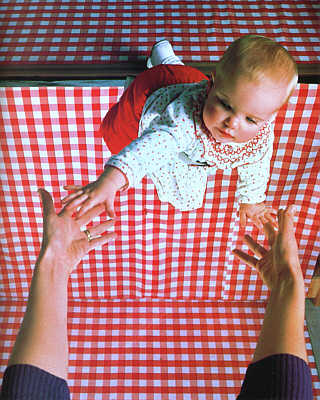In 1960, psychologists Gibson and Walk constructed a visual-cliff apparatus to study the depth perception of infants, positioning the very young across from their mothers, separated only by a plexiglass plate. Depth perception is typically grown before the ability to crawl, saving children from their own mishaps - ie. rolling off tables, chairs, and the like. Gibson and Walk found that in contrast to this, 75% of infants would brave the apparent drop-off when their mothers called to them from the other side, and were more responsive to these calls when the face across the cliff was smiling and encouraging. The psychologists concluded that humans are not born fearing heights, but develop this fear during the stages of infancy.
 |
| Some pretty cute babes ready to cross the glass. |
Two thirds of the way UP Chapman’s rock wall, I could go no further. The nimble, attractive man belaying me - who only minutes before had scaled this particularly difficult section of the wall in seemingly one breath - had stopped reminding me that I was doing well. I bring UP the visual-cliff study partially to have a laugh at my own infantile need for encouragement at all times, but also because I think the concept of the child-mind, itself, it what our conversation with Struppa was missing on Tuesday.
While I wholeheartedly agree with his critiques of extreme climbing culture and the motivations behind those who participate in such activities, I was intrigued by what in my personality was so on board with his selfishness message, when there were so many reasons to dismiss it in favor of more generous interpretations. As an artist, I think I relate on some small level to the Chancellor’s struggle to justify his own passion. Why am I, with all the resources I have been given, not doing something more useful or productive to help others?
Shoshin is the Zen concept of “beginner’s mind,” or “child’s mind” - the capacity of the individual to come to new or advanced study in any subject without preconceptions, with the mind open to all possibilities. In opening ourselves up to any sort of mindful practice, be it sport or art or other, if we are able to return to our fearless infancy, in times when fear is no longer useful to us, we may be able to eradicate the sort of pride Struppa discussed. “There is no courage without fear,” he quoted to us from I don't remember the source, but then there is no courage without pride. Simply investing in the act, without any self-perception of bravery, will help us on our journeys with the mountain, and will help us cross safely to our mothers, our return to the ground.
I cannot present a solid rationale for putting the lives of others at risk for our own sport, but I do believe seeking limits is a fundamental part of the human experience - like everything else, we must come at this endeavor with no expectations of ourselves. No fear, no courage, no pride - in order to keep a more true perspective.
 |
| alternate_nevermind_cover.jpg |
I wasn't going to only use photos of babies but once that google search happened it was all over.
http://www.kokdemir.info/courses/psk301/docs/GibsonWalk_VisualCliff(1960).pdf

No comments:
Post a Comment